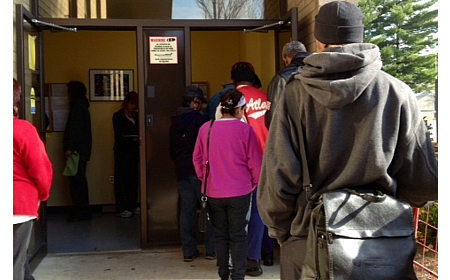
The Unseen Montgomery (Video)
Montgomery County is almost always among the top 10 in lists of U.S. counties with the highest family median incomes. It takes pride in being the economic engine of Maryland. Its schools make every list of the best in the nation. Yet, not easily seen, are pockets of poverty, especially families of working poor and people whose circumstances have taken dramatic turns for the worse due to the economic conditions of the past few years.
Starting Sunday, March 3, cable viewers in the County can get a glimpse of this hidden part of the County through a special version of the County Cable Montgomery (CCM) show The Bottom Line. The show, the idea for which was conceived by County Councilmember Nancy Floreen, is called The Unseen Montgomery.
The first broadcast of The Unseen Montgomery will be at 12:30 p.m. on Sunday, March 3. It will replay that day at 8 p.m. The next scheduled rebroadcast will be at 3:30 p.m. on Saturday, March 9. It will be rebroadcast at various future times that have yet to be determined. CCM is broadcast as Cable Channel 6 on Comcast and RCN and Channel 30 on Verizon. The broadcast also will be available via streaming at www.montgomerycountymd.gov/Council. It also can be viewed here.
The 30-minute show, which was produced and hosted by Susan Kenedy of CCM, points out that, on average, a Montgomery County family of four requires an income of $73,000 to provide for all of its living essentials. The show also points out that, over the past five years, the County has seen a 52 percent increase in the number of people receiving assistance from Supplemental Nutrition Assistance Program (SNAP—and formerly knows as Food Stamps) and that more than 5,600 families a month receive food from the Manna Food Center in Gaithersburg, a nonprofit that acts as the County food bank.
“We have people who once contributed here and now they are the ones who need help,” said a Manna employee in the show.
Floreen said people who only see the county’s affluence are missing a growing part of life in Montgomery.
“We have people in this county who have lost significant jobs and have been unable to find other employment,” said Floreen. “We have people who work two jobs, and when they add up their paychecks, they still do not have enough to pay their basic bills. And we have people who have moved to Montgomery from other countries and have not managed to settle in economically. They all live right here in our community and they need help—but they are not easy to identify.”
The show also looks at the February 2013 “SNAP Challenge” organized by Councilmember Valerie Ervin to bring a spotlight on the number of people in the County who live in poverty. Hundreds of people participated in the five-day challenge in which they volunteered to eat on $5 per day for a week—the average amount allocated to individuals who qualify for U.S. government food assistance. Council President Nancy Navarro, Council Vice President Craig Rice and Councilmembers Ervin, Floreen, Phil Andrews, Roger Berliner, Marc Elrich, George Leventhal and Hans Riemer all participated in the SNAP Challenge.
The show identifies nonprofits that provide help to those in need, including Manna; A Wider Circle, which collects used furniture and distributes it for free; and the Food Recovery Network, which collects unused food from dining halls and venue concession operators and gives it to nonprofit organizations that redistribute it to those in need. Other nonprofits featured include the Family Self-Sufficiency Program, a structured program that seeks to get people free of assistance, and Arleeta’s Pantry at the Woodside Methodist Church in Silver Spring.
“We wanted to do this show because all Councilmembers have been concerned with poverty in our county, and even in our toughest budget times over the past few years, we have taken steps to protect the County’s safety net,” said Councilmember Floreen.
Among those interviewed was a mother of three who said she works fulltime, but her net income is only $32,000—leaving not enough to fully pay her bills.
“We met many people who were working and combining that with assistance programs, and they were still struggling on a weekly basis,” said producer Kenedy.
The chief videographer on the show was Mike Springirth, who also was a producer of the show. Loren Olson was the program’s editor.

Engage us on Facebook
Follow us on Twitter
Tweets by @mymcmedia